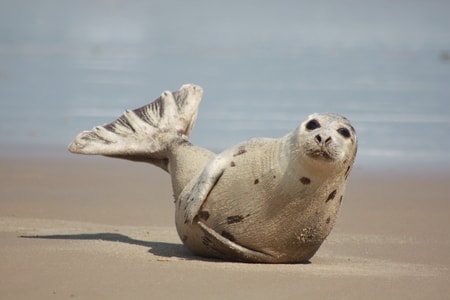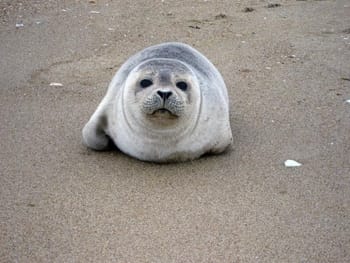What do Seals Eat

All seals are carnivorous marine mammals. Seals like to eat fish, squid, cuttlefish, octopus, Nautiloidea, cockles, scallops, clams, oysters, as well as sea birds, krill, crustaceans, and other bottom-dwelling invertebrates. Seals can hunt individually or collaboratively. When they hunt non-schooling fish or slow-moving prey, they typically use solitarily behavior. Seals usually swallow their whole prey underwater, but if the prey is large, the seal will tear the prey by taking it to the surface of the water. The Leopard seal is the main predator of penguins. Crabeater seals have cusped teeth which help them to remove the water before they swallow their planktonic food. The bearded seals like to eat clams, the ringed seals like crustaceans, and southern elephant seals like squid. The leopard seal hunt numerous other species, especially the crabeater seal. The great white shark, the tiger shark, and the mako shark as well as polar bears and the Killer whale are the major predators of seals.
Seals or Pinnipeds are natural groups of carnivorous, belonging to the order Carnivora. There are 34 extant seal species that comprise the earless seals, or true seals (Family Phocidae); the eared seals- sea lions and fur seals (Family Otariidae); Walrus (Family Odobenidae). There were also more than 50 extinct species that were described from fossils. According to "Seals World", 18 species of true seals are found on the earth. Six extant sea lion species are found on the earth as well as there is one extinct species such as the Japanese sea lion.
what do elephant seals eat/ what do leopard seals/what do harp seals/what do harbor seals/what do monk seals/ what do hawaiian monk seals/what do hooded seals/what do Bearded seals/what do Grey seals/what do Ribbon seals/
What do Elephant seals eat

Elephant seals are earless seals, belonging to the Family Phocidae and are the largest extant carnivorans on the earth. Two species of Elephant seals are found, namely the northern elephant seal and the southern elephant seal. The northern elephant seals are found in the eastern Pacific Ocean and prefer to spend most of their time in seawater.
Northern elephant seals consume different types of food like squid, lanternfish, jack salmon, krill, hyperiid, rotifers, copepods, water fleas, ratfish, small sharks, rays, etc. The male usually dives directly to the bottom of the ocean to catch prey but The female seals dive as deep as 500 m to 1750 m and stay there longer to hunt pelagic prey. Male Northern elephant seals prefer to forage along the continental shelf but females forage in the open ocean. Bioluminescence is the production and emission of light, which occurs largely in marine vertebrates and invertebrates. Bioluminescence is the production and emission of light, which occurs largely in marine vertebrates and invertebrates. This bioluminescence can facilitate their capture. The Northern elephant seals have a less developed echolocation system, but their whiskers are sensitive to vibration and are thought to play a role in the search for their prey.
The Southern elephant seals are the largest and heaviest seals. The Southern elephant seals are found in the South Atlantic, in the south Indian Ocean, and sub-Antarctic islands of the Pacific Ocean. Elephant seals can stay on land for the longest periods of time than any other seals.
The Southern elephant seals prefer to eat fish like lanternfish, cod icefish, as well as squid. For catching their prey, they dive frequently and each time they stay under the water for more than 20 minutes. They can dive to depths of 1300 to 3000 feet and have been recorded at depths of 7,835 feet. Seals spend a few minutes on the surface of the ocean to breathe.
They usually live alone. Male seals dive in the pelagic zones and also benthic zones for foraging but the females dive only in the pelagic zones. They consume glacial squid, Antarctic neosquid, sevenstar flying squid, greater hooked squid, mollusks, Gonatus antarcticus squid, as well as lanternfish, cod icefishes, crocodile icefish, grey rock cod, herring, deep-sea-smelts, krill, and algae.
What do Leopard seals eat

The sea leopard or leopard seal is found in the Antarctic Ocean and is the second-largest seal species after the Southern elephant seal and the species in the genus Hydrurga.
Leopard seals mainly live in the Antarctic pack ice from 50˚S to 80S. Stray leopard seals were spotted off Australia, South Africa, South America as well as New Zealand coasts. These solitary animals live in ice packs all year round.
The leopard seals primarily hunt a wide variety of creatures, including squid, krill, and fish as well as different species of penguins like King penguin, chinstrap penguin, and Adélie penguin, gentoo penguin, rockhopper penguin, and also emperor penguin. They rarely kill the other seal species the young southern elephant seals, Weddell seal, Ross seal, fur seal pups, crabeater seal, etc.
The leopard seals completely submerge in the water near the edge of the ice and wait for the penguins to enter the sea to hunt. Leopard seals have different feeding styles and they use suction to eat the krill.
What do Harp seals eat

The Harp Seal or Greenland Seal is a true seal, found in the Arctic Ocean as well as the northernmost Atlantic Ocean. The Harp seals prefer to eat several fish and invertebrate species, including Anacanthini fish like cod and other flat fish, as well as herring, capelin, krill, etc.
Because of their reliance on pack ice for breeding, the harp seal range is limited to those areas where pack ice forms seasonally. Based upon their pupping locations, they are divided into three populations Northwest Atlantic, the White Sea or the Barents Sea, and the Greenland Sea. The breeding areas of the Northwest Atlantic population are located in eastern Canada. This population breeds in Newfoundland, on the coast of Labrador, near the Magdalen Islands. The other population breeds in eastern Greenland. The third population breeds in the White Sea, the north coast of Russia.
In Summer, the White Sea population hunt and eat krill, flatfish, Anacanthini fish, herring, capelin, and polar cod in the Barents Sea. Western N. Atlantic harp seals prefer to eat capelin, American plaice, Arctic cod, Greenland halibut, etc.
What do harbor seals eat

The harbor seal or common seal is the most widely distributed pinniped species. There are five subspecies of the harbor seal, found in Europe and western Asia, eastern Canada, and western North America. They live in North Seas, northern Atlantic Ocean, Pacific Ocean, and Baltic Sea. They swim 50km to 160 km in search of migratory fish. They prefer to eat salmon, Alosinae fish as well as mossbunker fish, anchovy fish, sea bass, cod, flatfish, mackerel, herring, merling, etc. Occasionally they consume squid, crabs, shrimp, and mollusks. Harbor seals also kill and eat a variety of ducks.
What do Monk seals eat

Monk seals are found in tropical climates. There are two extant species of Monk seals-the Mediterranean monk seal and the Hawaiian monk seal but there was also an extinct species- the Caribbean monk seal, which was extinct in the 20th century. Currently, there are about 1,700 monk seals left on Earth.
The Hawaiian monk seals are found in the Hawaiian archipelago. This earless seal species is the only seal species that lives in Hawaii. About 1400 Hawaiian monk seals are living on Earth and are considered an endangered species. Most Hawaiian monk seals are living around the northwest Hawaiian Islands and a small population can be found around the main Hawaiian Islands. They spend most of their time foraging and can dive to depths of 300 to 550meters. They have the ability to hold their breath for about 20 minutes.
Hawaiian monks seals prefer to hunt and eat bony fish, cephalopods, lobster, squids, shrimps, some octopus species, eels as well as benthic fish, and pelagic fish.
The Mediterranean monk seal is an earless seal and the world's rarest pinniped species. Once they lived throughout the Northwest Atlantic Africa, coastlines of the Black Sea, into the Atlantic Ocean, and the islands including Porto Santo island, Canary Islands, Desertas Islands, and Madeira Island. They are also found in the Cape Verde islands.
Nowadays, Mediterranean monk seals are survived in the Aegean Sea and in the Cabo Blanco area in the Atlantic Ocean.
Mediterranean monk seals feed in shallow coastal waters and prefer to hunt and eat a variety of fish, octopus, eels, mollusks, lobsters, etc. They usually dive at depths up to 250 meters to catch benthic fish, and pelagic fish. It has even been observed lifting rock slabs in search of its prey.
What do Hooded seals eat

Hooded seals are endemic to the central and western North Atlantic. They live in pack ice and deep waters drifting in the Arctic Ocean and the North Atlantic. They prefer to live in the cold climates so they are found in the areas with pack ice like northeastern Newfoundland and Labrador, Jan Mayen island in Norway, the Davis Strait as well as the Gulf of St. Lawrence.
The hooded seals prefer to eat krill, amphipods, Atlantic and Arctic cod, capelin, fish, Greenland halibut, redfish, herring, squid, mussels, sea stars, etc. Typically, hooded seals dive to depths of 325 to 1,950 feet in the ocean in search of food, but they can go over 3,280 feet and stay underwater for up to an hour.
What do Bearded seals eat

The bearded seals or the square flipper seals are the true seals and are found in the Arctic and subarctic regions. They are also found in the Chukchi Sea, Bering Sea, and Beaufort seas, as well as Canada, Russia, Alaska, Norway, the Canadian Arctic Archipelago, the northern coast of Iceland, and Greenland.
Bearded seals prefer to eat a variety of small prey like squid, sea anemones, crab, shrimp, fish, polychaete worms, octopus, sculpins, sea cucumbers, arctic cod, clams, as well as pelagic and demersal fish. Adult bearded seals dive up to 300 m deep in shallow coastal areas to catch their benthic prey.
What do Grey seals eat

Grey seals or Atlantic seals are "true seals" or "earless seals", live in the North Atlantic Ocean. Grey seals prefer to eat a variety of benthic or demersal fish species. They can dive up to 1,560 feet and can stay more than one hour under the water. They have excellent vision and hearing which help them to hunt their prey. They prefer to eat Sand eels, herring, cod, flatfish, skates, lobsters, octopus, haddock, hake, crustaceans, as well as seabirds. They can consume about 5 kg of food daily but they do not eat every day and do not take any food during the breeding season.
What do Ribbon seals eat

The ribbon seal belongs to the family Phocidae. They live in the Arctic and Subarctic regions of the North Pacific Ocean, and the southern parts of the Arctic Ocean.
Their main diet is pelagic creatures, including North Atlantic marine fish, different ray-finned fish, squid, octopus, pollock, arctic cod as well as crustaceans. Ribbon seals dive to more than 200 meters in search of their favorite food.
What do Grey seals eat
Grey seals are true seals or earless seals, live in the North Atlantic ocean from the mid-Atlantic to the Baltic Sea. Three stocks of gray seals are found in the world. They are- the eastern North Atlantic stock, the western North Atlantic stock, and the Baltic Sea stock. The western North Atlantic stock is found in the northeastern United States and in the coastal waters of Canada. The world's largest colony is at Sable Island, Canada. The eastern North Atlantic stock is found in Norway, Great Britain, Russia, and Denmark.
The grey seals eat a variety of benthic fish species or demersal fish. Their favorite food is sand eels. They also hunt and eat herring, cod, skates, flatfish, as well as octopus, lobsters, etc. Recent studies suggest that gray seals also eat harbor seals and harbor porpoises.


.jpg)













0 Comentarios:
Post a Comment
Please do not use any abusing words or enter any spam links in the comment box